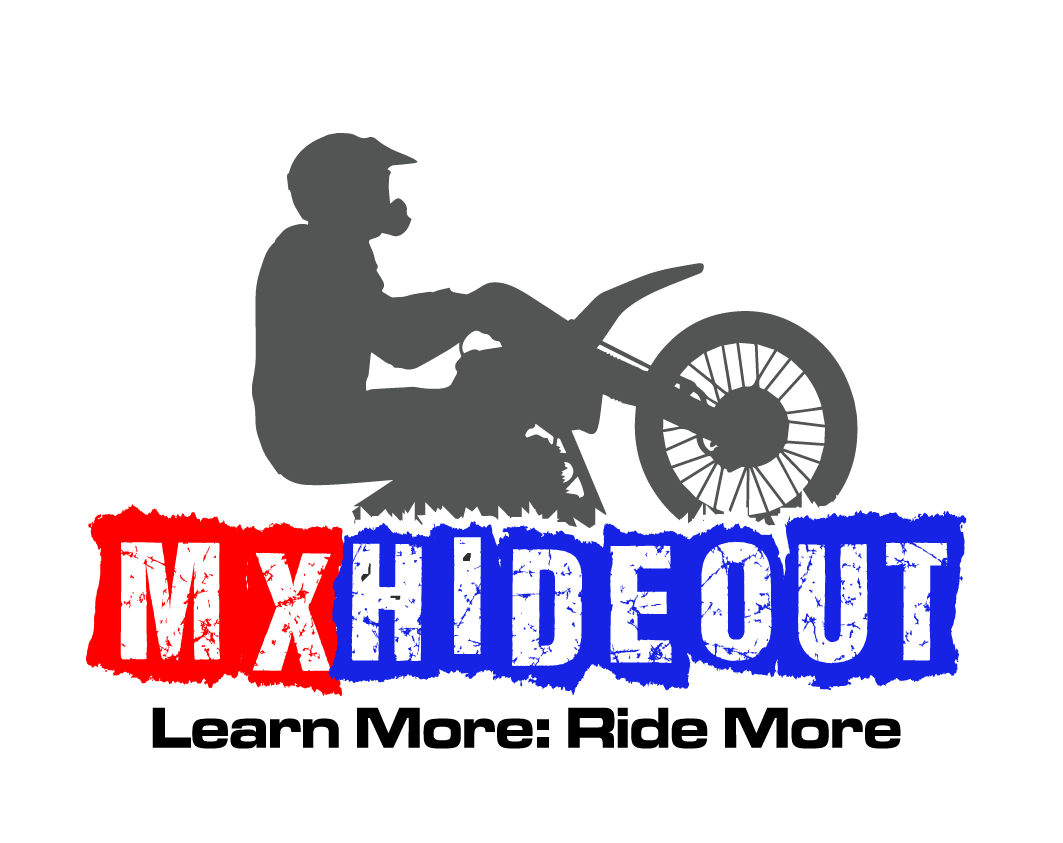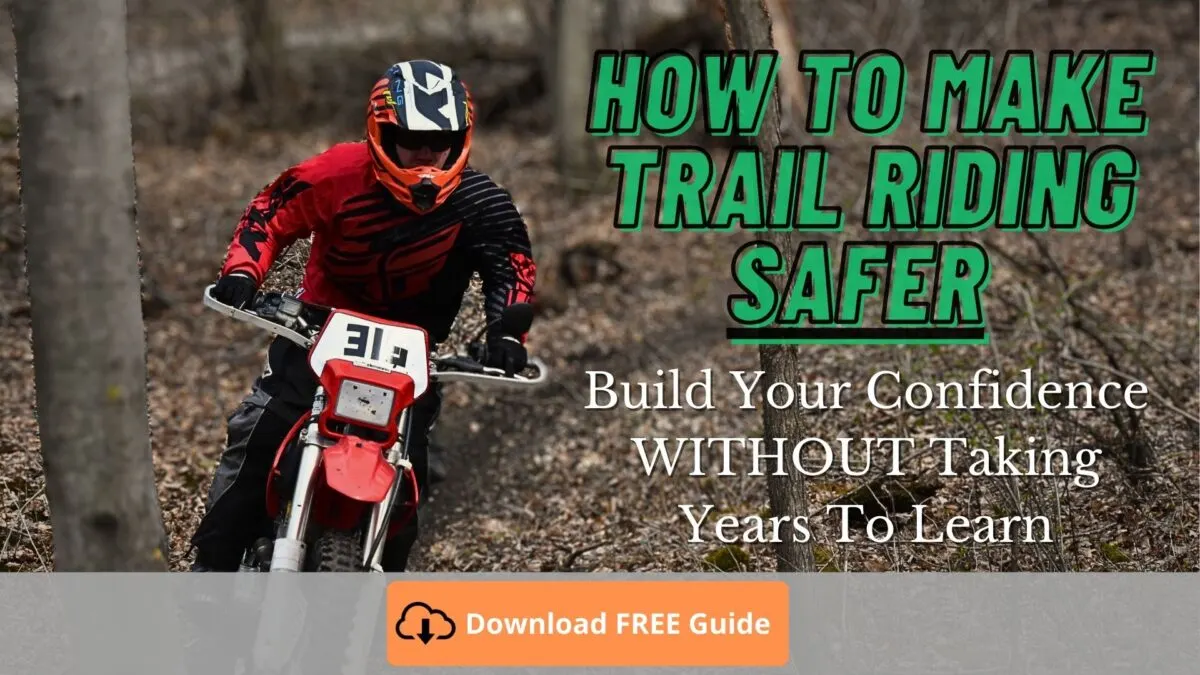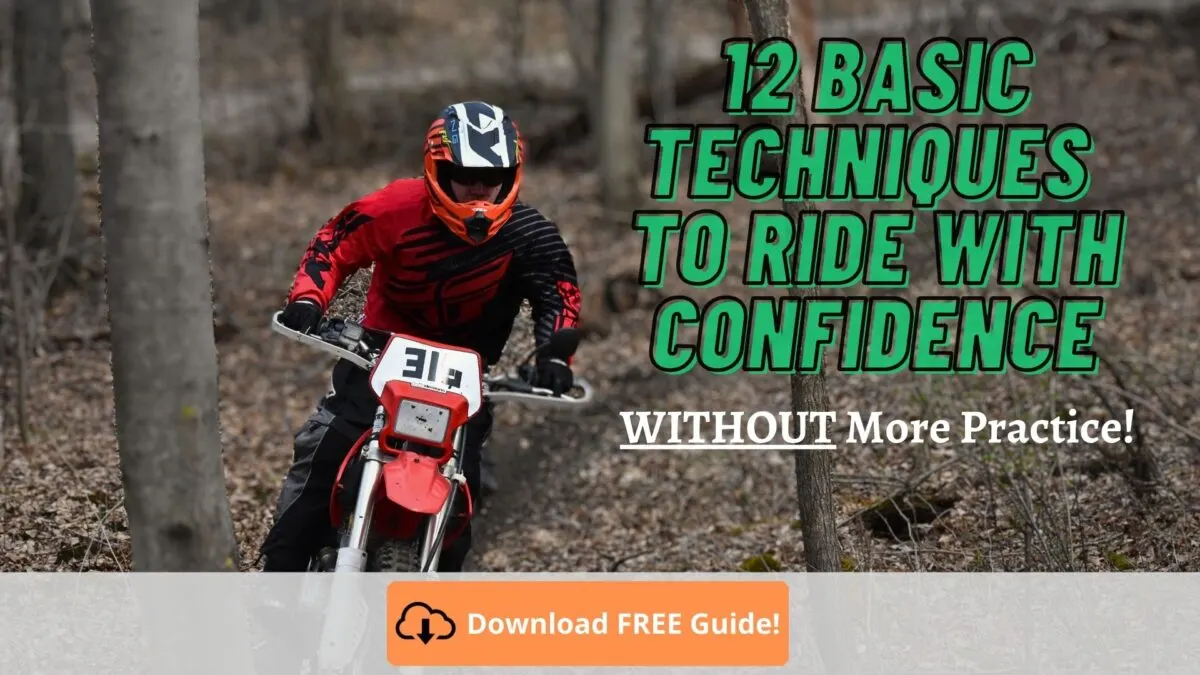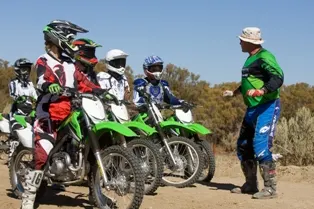Should you shift without the clutch, or will that damage your bike? I’m going to show you the best way to shift gears on a dirt bike, as well as practical advice to make riding more enjoyable and safer for you.
There are a lot of little things to learn when riding a dirt bike, and not everyone starts out knowing everything, so that’s why I’m here to help you with this article and video!
Is it hard to shift a dirt bike?
Nope, shifting the gears up or down is easy if your dirt bike is working properly. The hardest part about learning to shift a dirt bike is understanding which way to go with the shifter and when to time the shift properly.
You don’t want to be in 5th gear when you’re only going 5mph, and you certainly don’t want to shift down into 1st gear when you’re riding 45mph, or else you’ll have major safety consequences with you and your bike.
Dirt bike shifting diagram
On virtually all manual dirt bikes with a clutch, 1st gear is all the way down with the shift lever. Shifting up gives you all of the higher gears, while neutral is in between 1st and 2nd gear.
So a simple shiting diagram would be this:
- 6
- 5
- 4
- 3
- 2
- Neutral
- 1
How do you shift gears?
Starting in neutral, simply press down with your foot on the shift lever – this will put it into 1st gear (on most manual clutch dirt bikes).
Don’t push too hard; you can only shift one gear at a time, and if the shift lever breaks off then you’ll be stuck in the same gear.
To shift up, simply place the toes of your boot (foot) under the shift lever, briefly let off the gas, and then push up on the shifter.
How to shift without using the clutch
When you go to shift gears, especially going up a gear, simply let off of the throttle a little bit just before you shift. This will unload the engine (gears) and make it easy to shift without doing any damage to the transmission.
How do you shift gears smoothly on a dirt bike?
If you’re not using the clutch, then it just takes some practice to get it down smoothly. It’s a combination of smoothly rolling off the throttle while simultaneously shifting and then immediately rolling back on the throttle.
Sometimes I’ll use the clutch to shift gears more smoothly, such as when I’m on the road or have a passenger. Using the clutch to shift just makes it a little bit easier to be smooth because you aren’t getting all of the “backlash” of the gears accelerating and decelerating.
How To Shift With the Clutch
There are two ways you can shift through the gears while using the clutch. The first one, if you are conscience about the longevity of the transmission in your bike, is probably the easiest on it.
To shift gears on a dirt bike with the clutch, pull in the clutch and let off the throttle simultaneously, then shift and release the clutch.
Not only are you taking the load off of the transmission by letting off the throttle, but you are also reducing the load by disengaging the clutch. This is the most common way of shifting that is taught to new riders.
If it is what you are comfortable with, by all means, continue to do so.
Wide Open With Clutch
A powershift with the clutch is the fastest way to shift gears on a dirt bike, and a lot of professionals do it this way. Instead of letting off the throttle when shifting, you hold it open.
Sounds bad? You want to time it right so that it’s still in the power-band when shifting.
When you go to shift it up a gear, hold the throttle wide open and give the clutch a quick pull while shifting it up to the next gear at the same time.
It’ll sound like it’s over-revving, but it’s only for a split second if you’re fast enough. This is why four-strokes have a rev-limiter; so it stops revving higher before something breaks.
Two-strokes don’t have a rev-limiter because they stop revving before anything happens. Not only is this way of shifting fast, but it also keeps the RPM in the meat of the power-band when you get to the next gear.
How To Shift A Dirt Bike Without The Clutch
This next way to shift is still easy on the transmission, and the way I usually do it when riding around the farm/trails for fun. It’s the same as the first one, except it is a clutchless shift.
To shift a dirt bike without the clutch: let off the throttle, shift up a gear, then get back on the throttle to accelerate.
For some reason, many people think that dirt bike transmissions are like car transmissions and say you need to use the clutch to shift, otherwise, it will destroy the gears.
This is not true, as dirt bikes have a constant-mesh transmission. This allows you to shift up or down through the gears without the need for the clutch.
Just remember that it’s a sequential transmission, so you can only shift up or down one gear at a time, unlike a car where you can select any gear at virtually any time.
Wide Open Without Clutch
The last way to shift through the gears is probably the hardest on your transmission. Although it is made to take the abuse, many people would not recommend using this technique. Professionals do it because it’s faster, but they are using race bikes that are expected to have a much shorter lifespan.
When going through the gears, keep the throttle wide open, and when the power starts to run out near the end of the RPM range, firmly shift it up to the next gear.
This takes a little more practice, as you do not want to shift it while accelerating under a heavy load. Once you get to the end of the power-band, but before you hit redline/max RPM (rev limiter), is when you want to shift it. The bike will lose a little power at really high RPM, which will reduce enough load off the transmission to allow you to shift
Can you start a dirt bike in gear?
Yes, but you have to pull the clutch lever in to disengage it or else the bike will want to start moving. Some dirt bikes have a clutch safety switch so that it won’t start while in gear unless you pull in the clutch.
I always teach beginners to find neutral when re-starting their dirt bike for two reasons. It’s a good habit to quickly learn where neutral is, and it’s also easier to start most dirt bikes in neutral as opposed to being in gear.
Why is it harder to start a dirt bike while it’s in gear?
Even if you have the clutch pulled in, some dirt bikes are noticeably harder to start if you’re in 1st (or any) gear – especially when the engine is hot!
It’s more difficult because there’s still some drag on the clutch even if you pull the lever in all the way. This “drag” is caused by the friction of the clutch plates rubbing against each other and slows down how quickly the engine spins when kick-starting or using the electric start.
When the engine is hot, the clutch plates expand and cause even more friction, making it harder to start. If you’re racing and stall the engine, it’s easy to be anxious and try to re-start the engine while still in gear, but it’s often faster to find neutral and re-start it.
How to put dirt bike in neutral
Neutral is in between 1st and 2nd gear, so it’s easiest if you go down into 1st gear.
How to find neutral if the engine is running:
- Simply pull in the clutch and keep shifting down until it won’t shift anymore, then you know that it’s in 1st.
- Then shift half a click up to get it into neutral
- If you can let out the clutch (slowly) and the bike doesn’t move forward, then you know it’s in neutral
Finding neutral if the engine is not running:
- Shift down into 1st gear while rolling the bike back and forth just a few inches to make it easy
- Then shift half a click up to get it into neutral
- The bike will roll forward/backward more than 1 ft. if it’s in neutral (without pulling in the clutch lever)
When should I downshift my dirt bike?
Timing your downshift is all about listening to and feeling how your dirt bike is running. If you don’t care about speed and just want to casually come to a stop, simply pull in the clutch and shift down until you reach first gear.
If you want to stay in the right gear or want to use engine braking to help slow you down, then learning when to downshift is an important technique so that you don’t over-rev the engine.
Once the rpm starts getting low enough that it would bog the engine down if you tried to accelerate; that’s when you need to downshift.
Do you have to use the clutch when downshifting a dirt bike?
No, you don’t have to pull in the clutch. To downshift, just let off the throttle, click down on the shift lever, and then you can apply the throttle or brake again. The clutch does make downshifting slightly smoother.
Dirt Bike Won’t Go Into Neutral
The easiest way to find neutral is with the engine off. A dirt bike that won’t go into neutral may be a sign that the clutch is dragging or there’s a transmission problem, such as a bent shift fork.
With the engine off, roll the bike back and forth until you find neutral, in between 1st and 2md gear if you dirt bike has a clutch.
I believe that it’s personal preference and what kind of riding you are doing that should determine how you shift gears on your dirt bike. I am just telling you that it’s not going to blow up your transmission if you shift without using the clutch. I would know, because I’ve been doing it for years with no problems.
This is a good illustration of what your transmission is doing when you shift.
How do you know when to shift?
When teaching someone new to riding a motorcycle or dirt bike, I usually have to get them to understand the appropriate time to shift, or else they won’t do it properly.
The most common problem is waiting too long to shift. This puts more unnecessary wear on the engine because the rider stops accelerating at a high RPM but they don’t shift up to the next gear.
So, when is the correct time to shift each gear? My very definitive answer is: it depends…
Why? Because I change when I shift gears based on how aggressive or conservative I’m riding.
Shift timing for efficiency & endurance
When I’m trail riding or just casual riding I typically short-shift. This is simply shifting up once it gets into the midrange of the power. I like to use the low-end torque of the engine.
It’s also better for efficiency and increasing endurance on you and your dirt bike. Keeping it in the lower RPM makes the acceleration and deceleration smoother, there’s generally less vibration, and it upsets the suspension less than whacking the throttle wide open.
All of this helps your endurance because it’s easier to hang on. It’s also easier on the engine because you’re not spinning it as high in the RPM range. Less piston & crank revolutions = less wear and tear.
Shift timing for racing
Trying to get the holeshot, running through the gears on a long straightaway, or just racing your buddies? Each bike has its own “optimal shift point” to accelerate quickest through the gears.
The proper shift timing for racing is holding the throttle wide open and then shifting just past the peak horsepower RPM. This means that the instant the power flattens or drops off, it’s time to shift up a gear.
How to tell what gear you’re in
It’s almost always best to start in 1st gear from a stop, but what gear you shift into at any certain point is dependent on so many factors:
- Your bike
- The current gearing (sprockets)
- Where you’re riding
- What RPM you like to ride at
- How much you weigh
It doesn’t matter what gear you’re in while riding as long as the engine is spinning at an efficient RPM.
What I mean is that the engine doesn’t need to be at a high RPM unless it’s under a heavy load from accelerating. If you’re just cruising and don’t need to accelerate fast, then keep it in the midrange and lower.
(Even some of the top pros – such as Alex Ray in MX – don’t even know what gear they’re in after the holeshot)
How to become a better and safer rider on the trails
Learning how to properly shift your dirt bike is important, but that’s only the beginning when it comes to riding with confidence.
Want to quickly learn the actual techniques you need to ride with more control to prevent crashes? Tap here to get started.



